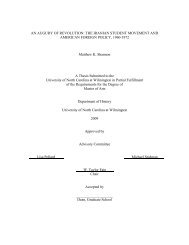Saprolegnia - The iLumina Digital Library
Saprolegnia - The iLumina Digital Library
Saprolegnia - The iLumina Digital Library
You also want an ePaper? Increase the reach of your titles
YUMPU automatically turns print PDFs into web optimized ePapers that Google loves.
<strong>Saprolegnia</strong> delica Coker, <strong>Saprolegnia</strong>ceae, p. 30, p1s. 4 (lower photo), 5, 6, 14 (lower<br />
photo). 1923.<br />
<strong>Saprolegnia</strong> parasitica sensu Coker, ibid., p. 57, pl. 18. 1923.<br />
Isoachlya parasitica (Coker) Nagai, J. Fac. Agric. Hokkaido Imp. Univ. 32:12, pl. 2, figs.<br />
27-34. 1931.<br />
<strong>Saprolegnia</strong> parasitica Coker emend. Kanouse, Mycologia 24:447, p1s. 12, 13. 1932.<br />
<strong>Saprolegnia</strong> pseudocrustosa Lund, Kongel. Danske Vidensk. Selsk. Naturvidensk. Math.<br />
Afh. 9 6:9, fig. 2. 1934.<br />
Isoachlya anisospora var. indica Saksena and Bhargava, Curr. Sci. 13:79, figs. 1, 2. 1944.<br />
Cladolegnia stagnalis (Tiesenhausen) Johannes, Feddes Repert. Spec. Nov. Regni Veg., p.<br />
212. 1955.<br />
<strong>Saprolegnia</strong> diclina var. numerosa Cejp, Oomycetes I, Flora ČSR, Ser. B, Part 2, p. 219.<br />
1959.<br />
<strong>Saprolegnia</strong> diclina var. minima Cejp, ibid., p. 219, fig. 78h. 1959.<br />
<strong>Saprolegnia</strong> crustosa var. similis Cejp, ibid., p. 224. 1959.<br />
<strong>Saprolegnia</strong> crustosa var. punctulata Cejp, ibid., p. 225. 1959.<br />
<strong>Saprolegnia</strong> shikotsuensis Hatai, Egusa, and Awakura, Fish Pathol. 12:105, figs. 1-9. 1977.<br />
Monoecious. Mycelium sparingly to moderately branched. Sporangia cylindrical,<br />
clavate, fusiform, or irregular; straight or slightly curved, sometimes faintly sigmoid;<br />
renewed internally, or in cymose or basipetalous succession; 75-1050 x 20-80 µm. Spores<br />
dimorphic; discharge and behavior saprolegnoid, or very rarely aplanoid; encysted<br />
spores 9-12 µm in diameter. Gemmae, when present, pyriform, obpyriform, cylindrical,<br />
clavate, or irregular; terminal or intercalary, single or catenulate. Oogonia sparse to<br />
moderately abundant, and often appearing in culture only after prolonged incubation;<br />
terminal, lateral, or intercalary, single or catenulate; spherical, subspherical,<br />
obpyriform, napiform, or slightly irregular, dolioform or subspherical when intercalary;<br />
spherical ones (30-) 50-70 (-130) µm in diameter, subspherical or obpyriform ones 54-146<br />
x 18-72 µm. Oogonial wall unpitted, pitted, or with pits only under the region of<br />
attachment of antheridial cells; pits sometimes inconspicuous; smooth. Oogonial stalks<br />
( 1 / 3 -) 1-1 1 / 2 (-3) times the diameter of the oogonium, in length; stout, straight or curved;<br />
unbranched or once-branched. Oospores centric or subcentric, both types occurring in<br />
some oogonia; spherical, (1-) 8-16 (>100) per oogonium, and may or may not fill it; (12-)<br />
18-26 (-44) µm in diameter; at germination forming a slender, irregular germ tube<br />
terminating in a small, cylindrical or clavate sporangium. Antheridial branches<br />
diclinous, rarely monoclinous or androgynous; slender, irregular, sparingly branched or<br />
unbranched; frequently, occasionally, or infrequently wrapping about or closely<br />
applied to the oogonium; persisting or deliquescing. Antheridial cells simple, very<br />
rarely compound; tubular or clavate, often irregular, sometimes branched or lobed;<br />
persisting or deliquescing; laterally appressed, very rarely apically attached to the<br />
oogonial wall; fertilization tubes, when present, persisting or deliquescing.<br />
628
















